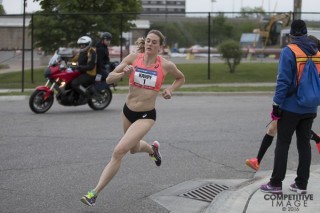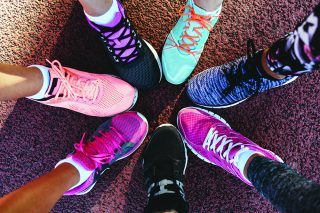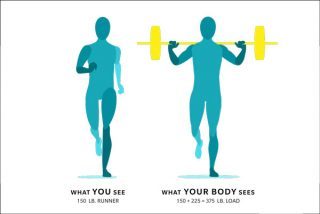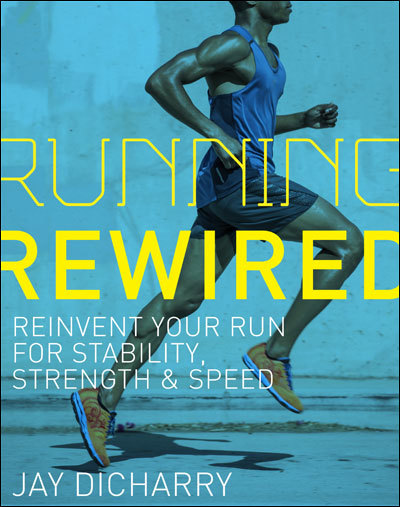Ryan Hall's Blog, page 115
March 5, 2018
Elite Field Dishes On This Year’s NYC Half
In just 13 days, the United Airlines NYC Half will kick off its 12th annual race. The March 18, 2018 race will debut its new course that
The post Elite Field Dishes On This Year’s NYC Half appeared first on Competitor.com.
March 4, 2018
Our Favorite Roger Bannister Quotes
The first person to break the four-minute mile was - and forever will be - an inspiration.
The post Our Favorite Roger Bannister Quotes appeared first on Competitor.com.
February 27, 2018
These Shoes Will Be Your New Lucky Charm
To offer runners a little extra luck this year, Brooks Running will debut the Launch 5 Shamrock Shoe to celebrate St. Patrick’s Day.
The post These Shoes Will Be Your New Lucky Charm appeared first on Competitor.com.
February 22, 2018
How to Shorten Your Race – Legally

Chances are your last half marathon wasn’t exactly 13.1 miles long. In fact, it’s likely your GPS said it was just a smidge over that: 13.4, perhaps, or maybe even more than 14 miles. It happens – a lot. By that logic, then, most courses are measured inaccurately…right?
Avoid putting too much stock in what your GPS watch says, cautions coach Mario Fraioli, founder of The Morning Shakeout newsletter and podcast. A myriad of variables can throw off your GPS reading, such as weather, poor satellite connection or tall buildings.
“I’ve literally watched people run a mile on a track and the GPS will beep in the middle of the final straightaway. The person told me that the track was ‘off.’ I just shake my head. The GPS watch isn’t helping these folks.”
Besides, the course is measured – multiple times – says Ted Metellus, Director of Course Operations for the Rock ‘n’ Roll Marathon Series. “All of our courses are measured by a certified member of USA Track & Field. In fact, each route is measured at least three times to verify its accuracy.”
So what gives? It’s all about the measurement tool. While everyone today runs with watches that utilize a satellite in the sky, course measurements are physically on the ground. Each mile marker is confirmed to the exact distance with the use of Jones Counter, a measurement device placed on the front wheel of a bicycle. As the bicycle travels the length of the course, the Jones Counter records the revolutions of the wheel.
The use of the Jones Counter explains another big reason why your race is seemingly longer: The bike always takes the shortest, straightest route. You probably don’t. That one factor can help you shave distance (and time) off your race.
“Learn what a tangent is and teach yourself how to run in a straight line,” says Fraioli. “Follow the line that’s closest to the turn to run the shortest distance possible when going around a corner. Also, avoid bobbing and weaving around other runners, as this will cost you time and energy.”
You may think you’re following the measured course by running to the right-hand side of the road, but it’s likely the course was actually measured on the middle or even left-hand side – especially on the corners. So long as the road is open to you, take the tangent. It’s one of the few times we’ll ever advise you to cut corners as a runner.
The post How to Shorten Your Race – Legally appeared first on Competitor.com.
February 21, 2018
Don’t Jog – Plogga!

Photo: Plogga
Move over hygge – there’s a new Scandinavian trend in town. Though 2017 was all about coziness and homespun pleasures, the latest big trend out of Sweden is about whipping the body and environment into shape.
Plogga – a title combining the Swedish words for “to pick” and “run” – is the hot new trend for runners. Though environmentally-conscious runners are nothing new (“pack it in, pack it out” has been a generally-accepted rule of runners for years) this is the first time the practice has been organized into a full-on running trend. Founded in 2016 by Swedish environmentalist Erik Ahlström, plogga involves organized running groups equipped with gloves and garbage bags. The objective? Pack out as much trash as you can from the trail or sidewalk.
It’s kind of genius, if you think about it – after all, picking up garbage is an unglamorous activity for many. But runners, who are naturally competitive, get an outlet for one-upmanship with plogga. Though plogging events aren’t competitions, many participants can’t resist the urge to pick up the most amount of trash in the shortest amount of time.
As evidenced by the many social media posts with hashtags #plogga and #plogging, the craze has caught on around the world. Organized plogging groups are popping up everywhere from Paris to Mexico. At last month’s Outdoor Retailer trade show, Ahlström and his crew led the first-ever plogging expedition in and around Denver.
In addition to helping the environment, the practice of plogging provides some big benefits for the runner – namely, in the form of squats and lunges performed while picking up trash. Who knew such good cross-training could come from a grocery sack and a pair of rubber gloves?
The post Don’t Jog – Plogga! appeared first on Competitor.com.
February 19, 2018
Cheap Vs. Expensive Shoes: Does It Matter?

Time and again, runners are warned about the perils of cheap running shoes – the oft-repeated justification for a pricey pair of footwear is that that running shoes are an investment – and don’t we want to invest in the very best?
But when the average price of a pair of running shoes in a specialty running store in $114, that investment can sometimes sting. Do you really get what you pay for? Yes and no, says RunRepeat founder and statistician Jens Jakob Andersen.
Though all-purpose athletic shoes are often sold at lower price points than shoes designed specifically for running, they’re also not designed to withstand the rigors of running; treads wear down faster, and uppers disintegrate earlier. That alone makes a compelling case for investing in a dedicated running shoe, which usually costs more than their all-purpose counterparts.
“While any shoe can be used for any activity, it’s important to note that running shoes are crafted to function more resiliently than regular sporty kicks,” says Andersen. “The reason why specialty running shoes get more appreciation than regular footwear is that they have the features, the materials, and the construction to go with their price tags.”
Shoes specific to running have a precise construction, designed to hold the foot, encourage forward motion, and maintain comfort. Andersen notes that running shoe technology is continually evolving, fueled by a distinct body of research that looks to create faster, healthier, and happier runners. All-purpose athletic shoes, on the other hand, haven’t changed much over the years: “General athletic shoes tend to reuse the same materials, the same assets, and the same blueprints. Their manufacturers hardly innovate; in some cases, they even imitate.”
But innovation comes at a cost – the more expensive a running shoe is, the more likely the design is a result of a lot of people doing a lot of research. Still, that doesn’t mean that pricier running shoes are always better. In fact, Andersen’s study of 391 shoe styles from 24 running shoe brands found that the higher the list price of a running shoe, the lower ratings from customers.
“Brands have strong incentives to promote high-priced running shoes, but our study very clearly outlines that runners buying more expensive running shoes are less satisfied than runners buying mid-range or cheap running shoes.”
In other words, technology is nice, but many runners prefer to stick with what they already know works for them. Because tried-and-true shoe styles from established brands sell well, more of them are produced, thereby driving down the cost.
At the end of the day, however, it comes down to individual preference. Some are willing to pay a higher price for a particular feature, be it energy-returning foam or an eye-catching design. Others swear by a shoe’s capacity for injury prevention or faster splits, making a high-priced shoe well worth the cost. Shoes are as individual as the runner wearing them – a new runner (or one in search of their sole mate) should on a variety of styles at a variety of price points, rather than simply assuming more money automatically equals a better shoe.
“Many people buy running shoes for their efficacy during their intended activity. On the other hand, there are those who purchase kicks just because they look cool,” says Andersen. “It all boils down to the wearer’s level of comfort regarding quality, design, price, construction, and features. The cost won’t become a sheet of discouragement if the potential buyer believes that what they have chosen is for them.”
The post Cheap Vs. Expensive Shoes: Does It Matter? appeared first on Competitor.com.
February 13, 2018
Feeling Bored? Here’s How To Reframe Your Run

If the statistics are right, the large majority of us who set New Years resolutions will abandon them by the time we reach February. It’s amazing how quickly we can go from inspired to indifferent. A bad case of motivational whiplash, our good intentions dissolve amidst the chaos and concern of everyday life. If that sounds like you, don’t worry, you’re not alone.
One of the major culprits that steals away our inspiration to take on new running goals is boredom. When we decide we to tackle our first 5K or finally knock the marathon off our bucket list, the first couple of weeks of training is often fresh and exciting, maybe even effortless at times. Soon enough, however, we begin to feel stuck—backed into a corner by a tedious routine we’ve committed to that doesn’t always feel like very much fun.
The driver behind that boredom is a lack of engagement in the process of training. We often approach running rather mindlessly, simply looking to plow through and check a workout off our to-do list rather than really immerse ourselves in the activity. It’s like you are literally running on autopilot. Interestingly, research suggests that we spend around half of our waking hours lost in thought—ruminating, planning, worrying—which causes us to miss the intricacies of what’s happening right in front of us. The result? Boredom and stress.
So what can you do to fight boredom and inject some new life into that training goal? Mindfulness is good place to start. At its core, mindfulness is attention training. It’s about bringing awareness to the present moment, training ourselves to notice when our minds have wandered, and gently guiding it back to the present. In paying attention to the task that is directly in front of us, we gain a greater appreciation for the richness of our experiences.
When I spoke with Dean Karnazes for my new book, Mindful Running, he told me this: “Running can be really boring, but boring is good. I think people need to shift their paradigm of boring.”
What runners like Karnazes have discovered is that when you peel back the layers and really tune into the panorama of the running experience, it’s not all that boring after all. One of the big keys to mindful running is curiosity. When you bring an inquisitive and attentive mind to the training process, you notice things about each run that are anything but mundane.
Take 10,000-meter Olympian Alexi Pappas’ approach. She is charged with racing 25 laps around a 400-meter track and says bringing curiosity to the moment is essential.
“I never get bored,” she told me. “I count laps and try to watch myself running the race as I’m running it—to almost amuse myself while everything is unfolding.”
So how might you leverage mindfulness to fight boredom on the run? Start with the following scanning exercises. You could spend a few minutes doing these at the beginning of every run or choose certain runs to devote to a mindfulness practice. As you move through each scan, try to keep you mind on the task at hand. If you get distracted, all mindfulness requires is for you to notice you’ve wandered and gently redirect back to the present. No harm done. These can be done in a wide variety of settings, just make sure you maintain an open awareness for safety.
Remember that in the beginning, keeping your mind on the present moment during these exercises can be especially difficult. Our culture trains us to constantly seek distraction. With that said, the field of contemplative neuroscience suggests that even a short-term mindfulness practice has the power to change the structure and function of the brain, essentially making present-moment awareness more second nature with training.
Environmental Scan
Bring awareness to your surroundings while you lace up your shoes.
As you get moving, spend a moment engaging each of your five senses to get a full picture of your environment.
Body Scan
Start by bringing awareness to the top of your head and scan down, over your face, your jaw, your neck, and shoulders.
If you notice tension, bring your attention to it and see if you can get it to relax.
Bring awareness to your arms and legs as they move.
Continue scanning down until you reach your toes.
Mind Scan
Identify the three thoughts that are most top of mind.
Take stock of the pace of your thinking. Is your mental weather calm today or hurried and frantic?
As thoughts pop into your head, see if you can simply label them, “that’s me worrying” or “that’s me planning” and then redirect your attention to your breath or your footfall.
Continue anchoring your attention to your breath or footfall for the rest of the run or as long as you’re comfortable doing so.
The post Feeling Bored? Here’s How To Reframe Your Run appeared first on Competitor.com.
February 12, 2018
Used Running Shoes A Treasure For One World Running

For most runners in the United States, a used pair of running shoes is an afterthought, tucked away in a closet somewhere or relegated to lawn-mowing duty after a race is over. But for runners in Nicaragua, Honduras, or other impoverished regions, those used shoes are a treasure.
Take, for example, Cuba: The average monthly salary is equivalent to approximately 25 US dollars. A gallon of milk averages about 8 dollars. A pair of Nike running shoes, at around 69 dollars, is a luxury most Cubans simply cannot afford.
Enter One World Running, a Boulder-based organization promoting health, fitness and nutrition by collecting, cleaning and distributing used running shoes to those in need around the world. Founded in 1986 by sports journalist Mike Sandrock, One World Running has distributed thousands of pairs of shoes worldwide.
The majority of the shoes come from individuals, running clubs or Girl Scout shoe drives. Shoes are dropped off at running stores or shipped to the OWR headquarters, and a Boulder laundry, Community Plaza, donates their services to wash the shoes. Shoes that are in poor condition are sent to Nike in Beaverton, Oregon, where they are ground up and made into running tracks and playgrounds; the ones that are in new or near-new condition are distributed through shipments or service trips staffed by volunteers.
Just recently, Sandrock and his director, Ana Weir, led a team of volunteers to Cuba, where they distributed more than 150 pairs of shoes (including brand-new shoes donated by Brooks Running), along with hats, shirts, and bags, to runners in the town of Baracaoa. It’s an annual trip for OWR, who aids the local running community in putting on the La Farola race, an 18-mile race up and over the Cuchillas de Baracoas mountains. Other service trips scheduled for 2018 include Belize in April and Honduras in June – shoes and volunteers are needed for both. For more information, e-mail director Ana Weir at anaweir@yahoo.com, or visit oneworldrunning.com.
RELATED: Cuba Libre! A Cultural Exchange in Running
The post Used Running Shoes A Treasure For One World Running appeared first on Competitor.com.
The Real Load of Running

The thrill of running can distract us from the reality of what is happening to the body with every stride. Your heart beats harder, pumping blood throughout the body. Sweat drips down your forehead as your body temperature rises. You feel the wind on your face as you turn round the track, up the trail, or down the road. These are the images that running conjures up in our heads and they are real, but while your heart and lungs are driving your engine toward redline, your chassis is under a lot of stress. Like it or not, your body must deal with 2.5 to 3 times its body weight with every single stride.
Think about this for a minute. If you stand up on both legs, you have half your body weight on each leg. And if you stand on one leg, that’s 100 percent of your body weight on one leg. Now take a barbell, add about 150 percent of your body weight to it, and hoist the load up and onto your shoulders; then stand on one leg.
Like it or not, this is how much stress your bones, tendons, muscles, cartilage, and ligaments support with every single stride you take. As runners, we’ve been told that distance running is a small amount of stress applied to your body for a long period of time. Well, we just shot that idea into oblivion. If anything, we could say that running is large stresses acting on our body for a long time.
Further complicating matters, running isn’t just a single-plane sport. In addition to these vertical forces, we also have to deal with braking and acceleration forces that amount to 40 to 50 percent of our body’s weight. And that’s while our body is kicked laterally by forces of around 15 percent body weight just from the effort of running. Running creates huge amounts of stress that act on the body from all sides with each and every step. No wonder running is hard!
This load acting on your body is absolute and somewhat mechanical. But your body’s response isn’t just mechanical. Imagine a rubber ball. If you throw a rubber ball off the roof, it will first accelerate to the ground. When it collides with the ground, the energy of the impact will flatten the ball out a bit and then the ball will rebound off the ground and spring back up again. The ball is passive—it compresses and rebounds based on the density of the rubber from which it is made. This is a simple illustration of how a passive object responds to load.
Now imagine you are soaring through the air in mid-stride and the same gravity that accelerated the rubber ball takes you back to earth. That’s where the similarity ends, because the body isn’t passive. It’s a complex system of parts with a neuromuscular system that actively moves, adjusts, and coordinates these parts in response to the mechanical forces of running.
Running hits your bones, muscles, and tendons with large amounts of force—it’s critical to control these forces. Learn more about how you can prepare your body for the stress of running. See more articles, self-tests, and exercises from Running Rewired.
Read the whole book

Running Rewired
Reinvent Your Run for Stability, Strength, and Speed
Jay Dicharry
America’s leading endurance sports physical therapist and coach shares a program for runners to become stronger, faster, and more durable.
The post The Real Load of Running appeared first on Competitor.com.
January 31, 2018
Elevate Your Run Performance By Taking The Stairs

Photo: Shutterstock.com
This post originally appeared on Triathlete.com.
To take an elevator to the top of China’s Shanghai Tower, 128 stories high, takes approximately 40 seconds—a technological marvel noted in the Guinness Book of World Records as the fastest elevator in the world. But Suzy Walsham of Australia would rather take the stairs—all 3,398 of them. It’s not that much slower, after all—running the Shanghai Tower took Walsham only 20 minutes and 44 seconds, a performance that contributes to her top standing in the Tower Running World Association.
Walsham, who entered (and won) her first “vertical marathon” in 2006, has dominated most of the 90 stair races she’s entered in the past 11 years. The sport, which requires lung-busting sprints up the stairwells of the world’s tallest towers, has helped Waltham become more fit in other forms of racing as well.
“I did 17:05 for 5K and 36:39 for 10K races last year,” says the 44 year-old Walsham. “Tower running has improved the strength and power in my legs, and I think mentally I am stronger, too, because tower running events are so tough.” And, she adds with a smile, running on flat surfaces feels comparatively easier after scaling buildings.
Stair workouts are easy to incorporate into any training routine, especially for those who are short on time. “A decent stair session can take 30 minutes or less,” says Waltham. It’s also a great option when the weather is bad, as most stairwells are temperature-controlled and protected from the elements. Stair training may also provide a workaround for injured runners—Walsham has stair-trained through muscle strains and Achilles injuries that were exacerbated by the road.
For those looking to take the stairs, it’s important to ease into the workout. “If you go out too hard, you’ll blow up. It’s quite different from running on the road, so understand that things get very tough, very quickly, as a lot of lactic acid builds up,” warns Walsham, who suggests introducing your body to stair workouts by jogging up 10 floors, taking a short rest, then doing 10 more. “As you get fitter, you can either reduce the rest time or increase the number of floors between rests.”
To add a strength component to a cardio-heavy stair workout, Walsham recommends taking the stairs two at a time, which requires more power, and using the handrail to pull up for a complete body workout.
Endurance Stair Session
This stair climbing workout is a staple of Walsham’s training for tower running competition, but also serves as a fitness test for upcoming road and trail races, especially ones that are hilly. “This session takes around 30 minutes, half of which I am running up stairs,” says Walsham. “If I can do this session I know I am in good shape.”
Warm-Up: 10 minutes easy running on flat elevation
Main Set: 10 x 30 floors with 3-4 minutes recovery (Walsham takes the elevator down to the first floor)
Cool-Down: After final repetition, walk down stairs.
The post Elevate Your Run Performance By Taking The Stairs appeared first on Competitor.com.
Ryan Hall's Blog
- Ryan Hall's profile
- 21 followers



